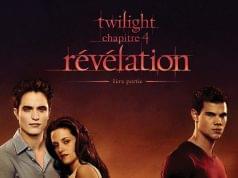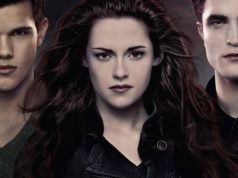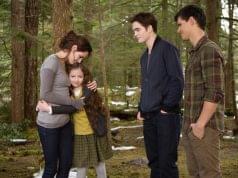Look, I know the drill. If any element of the “Twilight” movie varies even slightly from the way you pictured it in your head, then it is the worst film ever made and you hate it and Catherine Hardwicke has ruined your childhood. Or, alternatively, you’ve built up so much anticipation for the movie that you’re going to love love LOVE it no matter what, even if it’s bad, you don’t care, you refuse to listen to any criticisms LA LA LA I CAN’T HEAR YOU. I know how it goes.
The book’s most devoted fans are seeing the film anyway, so I guess I’m talking to everyone else — those who haven’t read the book, or who (like me) read it, mostly enjoyed it, then didn’t give it another thought. Is the “Twilight” movie of any use to those people? Or, as a friend asked me, does it work purely as a vampire movie?
Oh, heavens, no. Noooooo. This is not a vampire movie. This is a somber teen romance that happens to have some vampires in it. Little attempt is made to establish the mythology of the bloodsuckers, and the supernatural elements are downplayed — a wise move, since the special effects, when they are necessary, are at about the level you’d expect from a movie that is more focused on romance than sci-fi action.
All of which is in keeping with the tone of Stephenie Meyer’s book, which is eight parts romance and two parts action/fantasy. That’s why it’s been such a phenomenal success with women, and why the male-dominated geek industry — the Nerderati, if you will — has been so skeptical of that success. “What?” they scoff. “A super-popular vampire book that we, as men, AREN’T interested in? Inconceivable! It must be terrible, and its popularity is probably being over-reported!”
The screenplay, adapted by Melissa Rosenberg (TV’s “Dexter”), is faithful to the plot of the book, if not to all the details. Bella (Kristen Stewart), a somewhat introverted 17-year-old Arizona girl, moves to her dad’s house in a podunk Washington town that exists in a perpetual gloom of rain and fog — the perfect place for a clan of vampires to call home. A few of them attend Bella’s high school (incognito, of course), where they are held in awe by the other students for their physical beauty and aloofness. They claim to be the foster children of the good-hearted Dr. and Mrs. Cullen, and they keep to themselves.
Yet one of their group, Edward (Robert Pattinson), is smitten with Bella, and she with him. A tentative romance develops, punctuated by much secrecy and awkwardness on Edward’s part. The Cullens are a noble camp of vamps who refrain from feeding on humans, but the urge is still there, and it means Edward can’t let himself get too passionate with Bella lest he lose control of himself and get all bitey-sucky-killy. If nothing else, “Twilight” is a compelling ode to the benefits of chastity.
“Twilight” (2008) B-
My Rejected ‘Twilight’ Screenplay
“New Moon” (2009) C+
My Rejected ‘New Moon’ Screenplay
“Eclipse” (2010) B
My Rejected ‘Eclipse’ Screenplay
Five Product Ideas Better Than Bella Swan’s Engagement Ring
“Breaking Dawn — Part 1” (2011) B-
My Rejected ‘Breaking Dawn — Part 1’ Screenplay
“Breaking Dawn — Part 2” (2012) B-
My Rejected ‘Breaking Dawn — Part 2’ Screenplay
Dear ‘Twilight’: Thank You for Ending
So the plot remains mostly intact — but more importantly, what Hardwicke captures extremely well is the FEEL of the book. The director of such gritty teen fare as “Thirteen” and “Lords of Dogtown,” Hardwicke has a knack for wistful, angst-ridden teenage melancholy, and it’s in full bloom in “Twilight,” where the overcast skies complement the stormy, forbidden romance. The soundtrack is stocked with moody acoustic-guitar tracks, and Bella’s contemplative narration takes us into her confidence like a diary. I think Hardwicke has got the tone of the film exactly right.
One of the reasons I only liked Meyer’s novel rather than loving it was that it felt bogged down by endless descriptions of how beautiful Edward was. Don’t get me wrong — I love hearing about hot 17-year-old boys as much as the next person. But the continual mooning and swooning made me impatient.
In the film, of course, this is mostly eliminated. There is no need to tell us about Edward’s beauty when he’s right here in front of us and we can see for ourselves (assuming we are not distracted by his tall, disorderly hair, that is). But in the process, the film has trimmed down Edward and Bella’s interaction, or at least it feels that way. Their love seems to be assumed rather than demonstrated, and there’s some stilted, clunky dialogue in their early scenes together. It doesn’t help that Pattinson’s version of “awkward” looks and sounds like most people’s version of “stoned,” or that he is required to say things like “I don’t have the strength to stay away from you anymore” and “You’re like my own personal brand of heroin.”
There are other problems, too, mostly with the Cullens, who always appear to be practicing their Zoolander Blue Steel faces. Edward’s vamp-sister Rosalie (Nikki Reed) is antagonistic toward Bella, but the film doesn’t explain or do anything with that fact. The vampires’ pale skin is represented by too much powdery face makeup, which makes Dr. Cullen (Peter Facinelli) in particular look like a mime. The crucial baseball scene, with the Cullens whacking one homer after another out in a forest clearing, is underwhelming. (In a game of vampire baseball, do they use vampire bats? Get it? Vampire bats? I got a million of ’em!) Other elements, like the mere presence of Bella’s friend Jacob (Taylor Lautner), were apparently included only because 1) they were in the book, and 2) they’re needed to set up the sequels.
With only a few moments of levity, “Twilight” is by and large a serious story about serious things — things like love and death and vampires, that is. Anyone who can’t accept such a silly premise as fodder for sober contemplation would do well to steer clear of it, but those willing to consider a vampire-based teen romance should find this one suitable, if not everything they dreamed it would be. As Bella could tell you, life doesn’t always turn out the way you wanted it to.
B- (2 hrs., 2 min.; )





